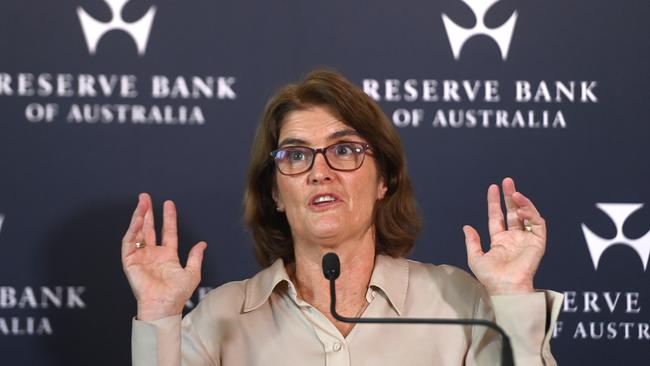Financial risks are ‘contained’ despite the strains for some, says the RBA
The RBA’s health check of the financial system shows risks to households, businesses and commercial real estate are ‘contained’ despite soaring interest rates and cost of living.

Business
Don't miss out on the headlines from Business. Followed categories will be added to My News.
The Reserve Bank’s latest health check on the financial system says the risks from lending to households, businesses and commercial real estate “remain contained”, but subdued economic growth and higher unemployment are expected to present further challenges for some.
“These strains could be magnified if inflation were to remain high for longer than anticipated or if economic conditions were to deteriorate by more than expected,” the RBA says.
In its half-yearly Financial Stability Review, the central bank notes that real disposable income per capita has fallen back to pre-pandemic levels after soaring on the back of fiscal and monetary policy stimulus.
Lower-income households and many renters have felt these budget pressures “acutely”.
Sharply higher housing costs for borrowers and renters and broadbased cost-of-living pressures have weighed heavily on household budgets and contributed to very weak consumer sentiment.
“Information received through the RBA’s liaison program indicates that more people than usual including wage earners and mortgagors are seeking support from community organisations,” the RBA says. But despite these pressures, almost all borrowers have been able to continue to service their debts. Less than 1 per cent of housing and personal loans are at least three months in arrears.
“While housing and personal loan arrears have increased since late 2022, they remain below their pre-pandemic peak,” the RBA says. “At the same time, a small but increasing share of borrowers have requested and received temporary hardship arrangements from their lenders, which has contributed to arrears rates remaining a little lower than would have otherwise been the case.”
Based on their latest assessment of the economic outlook, banks expect arrears rates to increase a bit further from here but remain low relative to history.
A strong labour market, cuts to household spending, and larger than normal savings buffers have allowed households to cope with rising interest rates and high inflation.
Most borrowers are still able to service their debts and cover essential costs with their income.
About 5 per cent of variable-rate owner-occupier borrowers are thought to have minimum scheduled mortgage payments plus essential expenses that exceed their income, leading to a cash flow shortfall. These households are likely to have little capacity to cut back on spending.
However, while it has increased from about 1 per cent in April 2022, the RBA’s estimate of the percentage of variable-rate owner-occupier borrowers in this group is unchanged from October.
Also, many households with an estimated cash flow shortfall still have substantial savings buffers.
The share of borrowers more at risk of falling behind on their loans – those estimated to have a cash flow shortfall and low buffers – has increased over the past two years.
However, it is still less than 2 per cent of variable-rate owner-occupier borrowers.
“Nearly all borrowers are expected to be able to continue servicing their debts even if budget pressures remain elevated for an extended period,” the RBA says.
Whether or not budget pressures gradually ease as implied by the latest RBA forecasts or inflation is more persistent and interest rates remain higher for longer than currently expected, the vast majority of borrowers are expected to remain able to service their debts on schedule.
Scenarios tested by the RBA include one where the cash rate falls from its current 4.35 per cent to 3.2 per cent by mid-2026, and another where the cash rate tracks 50 basis points higher.
In the latter scenario, the proportion of cash-flow negative households only rises to 6 per cent before falling next year, according to the RBA’s modelling.
“If budget pressures ease in line with the February statement forecasts, the share of households with an estimated cash flow shortfall will decline later in 2024,” it said.
“Should inflation remain high for longer than forecast, the small number of borrowers who are close to or in cash flow shortfall would have to make further difficult adjustments to their finances in order to meet their obligations.”
In both scenarios, 2024 will remain a “challenging year” for those borrowers who are already experiencing acute budget pressure, the RBA warns.
The cumulative effect of moderating inflation, higher real wages and a lower cash rate over the next two years is expected to “help to ease pressure on borrowers with stretched finances”.
As nominal wages growth exceeds inflation, a rise in real wages and fall in interest rates is estimated to lead to about a halving of the share of borrowers with a cash flow shortfall by the end of 2025.
But the RBA says much of this year will “remain challenging for borrowers already under pressure” as the expected fall in the share of borrowers with a cash flow shortfall only occurs “later in 2024”.
A rise in unemployment would “severely impact the cash flow of borrowers affected by job loss”.
“The expected 0.5 percentage point increase in the unemployment rate would push most affected borrowers into a cash flow shortfall,” the RBA warns.
But this isn’t expected to translate directly into mortgage defaults. In a “severe but plausible downturn”, a larger-than-expected increase in the unemployment rate would “increase financial stress among affected borrowers”.
“Still, risks to the financial system would likely remain contained,” the RBA says.
Further supporting financial system resilience, most borrowers have strong equity positions, which protects them from default and limits lenders’ losses.
“Sound lending standards and the general increase in housing prices over recent years continue to support borrowers’ resilience,” the RBA says.
“While usually a last resort and very disruptive for owner-occupier borrowers, this would allow almost all borrowers to sell their properties and repay their loans in full before defaulting.”
Few borrowers are in negative equity on their mortgage, limiting the impact on lenders in the event that some default, the RBA says.
Corporate profitability has remained around pre-pandemic levels for most businesses and generally strong balance sheets have limited the risk of widespread corporate stress. Conditions are challenging in commercial real estate, but there is little evidence of financial stress.
Originally published as Financial risks are ‘contained’ despite the strains for some, says the RBA



